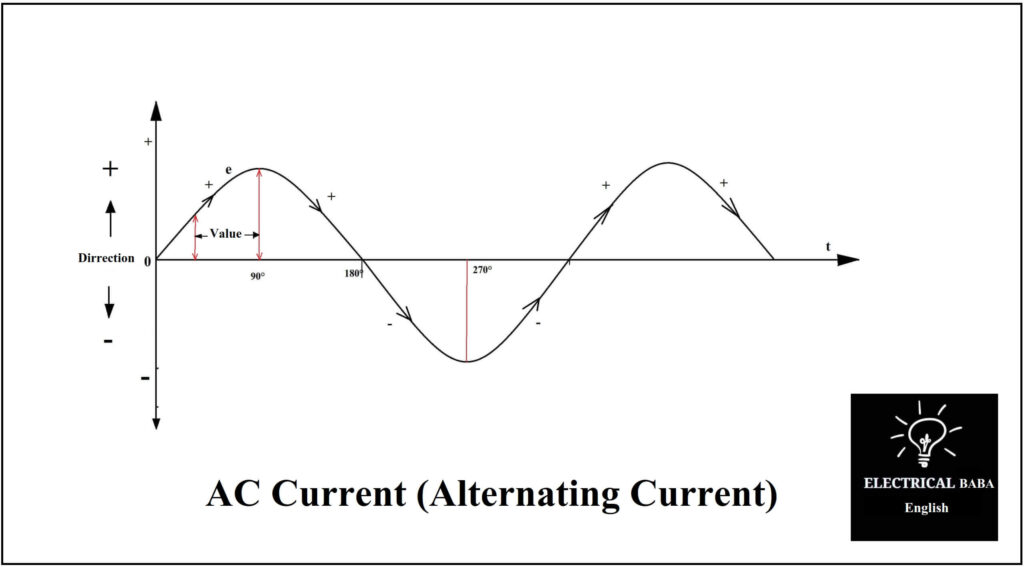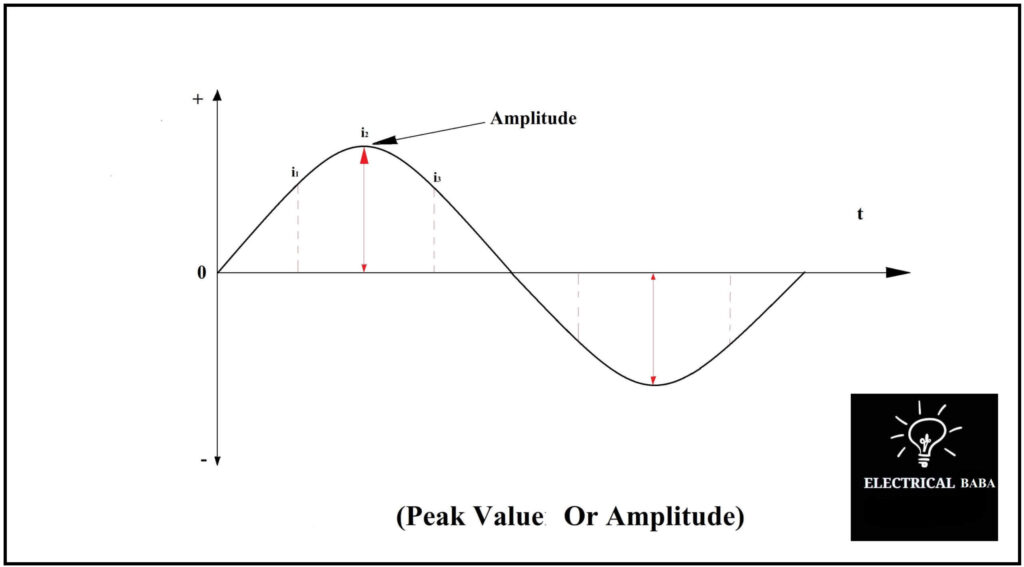Guys if you are in ITI Electrical field, or interested in Electricals. You want to know about AC Current. So read this article
Definition of AC Current (Alternating Current)

Electric current which always changes its value and direction, that current is called AC current (alternating current). When an electromagnetic field changes through a conductor. Then EMF (Electro Motive Force) is formed in that conductor according to Faraday’s law of Electro Magnetic Induction. (Force that moves electrons)
Why is AC Alternating Current generating more electricity than DC electricity?
AC power generation is cheaper than DC power generation. Also AC Voltage can be easily increased or decreased with the help of Transformer. This makes it cheaper to transmit electricity from one place to another and to distribute it to the load of electricity customers.
Large factories use more AC motors than DC motors. AC power continues to be used extensively for domestic use. 98% of the total power generation is generated from AC power.
Read More..
- Continuity Test and Short Circuit Test: Why are They Necessary?
- What is Relay Modules: Functions and Applications for Beginners
- India’s Electric Power: Infrastructure Overview from Generation to Distribution
- Single Phase Induction Motors: Types, Functions, and Uses
- What is 3-Phase Induction Motors: Types, Structure, and Principles”
- What is Power Factor?| How to improve power factor in AC Circuits?
- What is an electric substation? | Types Of Electric Substation?
- What is Neutral In Electrical? | Purpose of Neutral Wire in electrical Circuit
- What Is Star Connection And Delta Connection?
- What is an Alternating Current? | Definition of AC Current
Some important definitions in terms of AC Current (Alternating Current)
AC Cycle

A whole current of 360 के of AC Current or AC Voltage is called 1 AC Cycle. In AC EMF formation when a conductor rotates between two magnetic poles. In that one turn of the conductor, one turn of Alternating Current and AC Voltage is also completed.
Current or Voltage in an AC Cycle changes its direction twice. The direction of Current or Voltge in half round of AC Cycle is exactly opposite to the direction of the other half of Cycle. Their value also varies in an AC Cycle.
what is AC Time Period?
The time that it takes to complete one round of AC Current or AC Voltage (1 AC Cycle) is called AC Time Period (AC Time Period).
what is Frequency?
Cycles of AC Current or Voltage are completed in one second. The number of those cycles is called Frequency.
The symbol F is used to indicate frequency. And the unit of frequency is Cycle / Second (C / S) or Hz.
Frequency varies in the power generation system of every nation. Frequency 50 Cycles / Secons has been fixed in our country India. Frequency prescribed as per Indian Electricity Rules should not change more or less by 3%.
what is Peak Valuer Or Amplitude?

what is the Scaler Quality?
The amount which has value but no direction is called Scaler Quantity. Example weight, time, length, etc. Such amounts can be measured in scale. In addition and subtraction of scalar quantities, only their value is considered.
what is the Vector Quantity?
The amount which has its own value and direction is called vector quantity. Example- Acceleration, force and all the sums of AC System.
(→) is used to denote the vector sum. Vector means a long line with an arrow mark at the end.
The length of such a line means the value of that Vector and the arrow sign means the direction of that Vector. That is what it means. For addition or subtraction of vector sums, addition or subtraction of numbers cannot be done. Apart from numbers, direction is also considered.
Example figure
what is the Phase?
The existence of a vector at any moment in the AC Cycle means a phase.
If two AC Generators are started at the same speed at the same time, then the Cycles of Voltage produced in both the Generators will be as given below.
Figure
what is In-phase?
In an AC power system, two or more sums (Current or voltage) start at zero at the same time and reach their maximum value at the same time. And from there if at least at the same time ‘0’ reaches zero, then those amounts are called In-phase.
what is Out of Phase?
In a C electrical system, two or more sums start back and forth at the same time without starting from ‘0’ zero. And at the same time they reach back and forth without reaching their highest value. And back and forth ‘0’ has reached zero. Those amounts are called Out of Phase.
Figure
what is the Phase Difference?
The partial angle located in two quantities in an AC electrical system is called Phase Difference. It is counted in Electrical Degree or Radians.
1 degree = 0.017 radians, 1 radian = 57.69 degrees
Any in-phase sum has a Phase Difference of zero fraction ‘0’. And Out of Phase amount has Phase Difference between 0 to 90 (theta) degree.
Power Factor | What is power factor?
The cosine ratio of the Phase Difference between any two A C quantities is called Power Factor.
Power Factor = Cos θ (Theta)
Why is the power factor only between 0 and 1?
The AC Circuit can have a Phases Difference of a maximum of 90 degrees and a minimum of 0 degrees between any two quantities.
Therefore Cos 90 = 0 and Cos 0 = 1
Thus any AC Circuit has a maximum of 1 and a minimum of 0 Power Factor.
what is the Inductance?
If AC Suplay is given to a coil then the current flowing in that coil keeps changing its direction and value continuously. Due to this the process of self induction takes place in the coil.
If a second coil is placed near the coil connected to the supply, then the action of mutual induction takes place in the second coil, and EMF is formed in that second coil.
The EMF (Electro Motive Force) formed in this action of Electro Magnetic Induction resists the force of current flowing in the first coil according to the law of lens.
If we assume this, then the coil has the property or characteristic of resisting the force of AC current flowing in the coil. This property is called inductance. The definition of inductance would be something like this.
what is the Definition of Inductance?
“The property that resists the changing current flowing in the coil is called inductance.”
The symbol for inductance is L. And its unit is Henry.
what is the Henry?
If a coil changes by 1 ampere in a second. And if 1 volt is formed in that coil by that change, then the inductance of that coil is called 1 Henry.
what is an Inductive Reactance?
If AC supply is given to a coil. So the resistance in current flowing from the coil is called Inductive Reactance.
It can be represented by X l. And count in Ohm.
what is the Capacitance?
The property of a capacitor to store electric energy in the form of an electric charge is called capacitance. The unit of capacitance is farad (F) and its code is C.
what is Faraday?| What is the definition of a Faraday?
If 1 volt potential difference is found due to one coulomb (1 ampere × 1 second) in the capacitor, then the capacitance of that capacitor is 1 farad.
what is Capacitive Reactance?
The resistance in a current flowing in an AC circuit from a capacitor. It is called Capacitive Reactance. Its code is Xc. Count it in ohms.
Reactions
Inductive reactions and capacitive reactions.
what is Impedance?
The sum of the vectors of resistance and reactance in the AC circuit is called impedance. Impedance is the total resistance of the current flowing in the AC circuit. Its code is Z. And count it in ohms.
what is Conductance [G]
The component that occurs against resistance is called conductance. Its code is G and its unit is mho.
what is Acceptance [B]
The component that occurs against reactions is called receptors. Its code is B. And its unit is mho.
what is Admittance [Y]
The component that occurs against impedance is called admixture. Its code is Y. And its unit is mho.
You should also read this
| Home Page | Click here |
| Electrical Theory | Click here |
| Earthing | Click here |
| Electrical Equipment | Click here |
| Free Electrical Training | Click here |
| Transformer | Click here |


